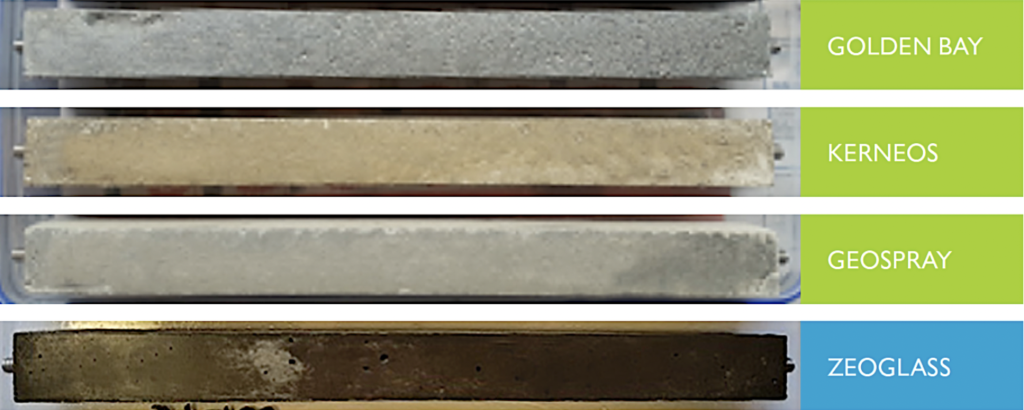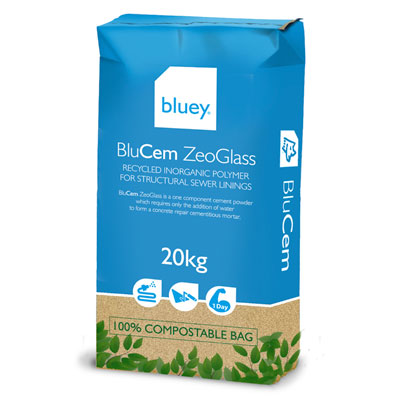In the early stages of the BluCem ZeoGlass (ZeoGlass) development and approval process, we teamed up with The University of Sydney to conduct a test program, to analyse the “leading” sewer lining shotcretes and see how they perform next to ZeoGlass.
These commonly used products consist of a geopolymer based shotcrete, a calcium aluminate cement and a proprietary acid resistant cement. We were excited to test ZeoGlass because not only does it have an advanced acid and chemical resistant binder system but, most significantly, it uses recycled Australian glass as an aggregate, along with other waste by-products, which makes up 60% of the entire product.
Benefits Include:
| – Made from 60% recycled waste materials | – Extremely high acid and chemical resistance | ||
| – High compressive, flexural & bond strength | – Ultra-high build in one pass | ||
| – Negligible rebound | – Fast application | ||
| – Minimal dust emissions | – Easy to hand trowel. |
This type of testing, (accelerated age testing), exposed the four products to the same amount of acidity that they would expect to receive in a sewer application over a 40-year period.
Two separate test programs have been run now on the products to verify results. The conditions for each of the 18-month test programs included the submersion of all four products in a highly concentrated acid bath; think Breaking Bad – but worse.
The following images and notes were taken at each respective time interval during laboratory testing.
Zero Exposure
 The image above, shows the four samples on the first day of the test program.
The image above, shows the four samples on the first day of the test program.
6 Months Exposure (10 Years Under Standard Sewer Conditions)

Golden Bay AR Cement is in a very poor condition. Reference pieces are now too exposed to measure length accurately. The prism sides have swollen with material lost to spalling. 
Kerneos CAC started to lose its alumina gel coating; previously evident as a ‘surface slime’. Surface now heavily eroded. Prism sides indicate +8% expansion with a +0.02% length change.

Millikan Geospray has lost 22% of its original weight through surface erosion. 12% of the material has been lost from the prism sides.
 BluCem ZeoGlass has retained its dimensions.
BluCem ZeoGlass has retained its dimensions.
12 Months Observations (20 Years Under Standard Sewer Conditions)
Golden Bay AR Cement lost 25% of its original weight at 1year. Reference pieces are now loose therefore testing discontinued. The increase in length was +0.081% and it appears much of the swelling and spalling was from the sides of the prism.
 Kerneos, after 12 months acid exposure, recorded a mean weight loss of 7.43%. This appears to be primarily a loss of alumina gel. Exposed fibres are clearly evident.
Kerneos, after 12 months acid exposure, recorded a mean weight loss of 7.43%. This appears to be primarily a loss of alumina gel. Exposed fibres are clearly evident.

Millikan Geospray recorded a 33.8% weight loss, over the 12 months. Another alarming feature is the -0.61% shrinkage after 12 months acid sulphate cure and a +0.39% expansion under regular water cure over the same period, suggesting a relatively unstable binder. Testing has been discontinued on this sample.
 BluCem ZeoGlass shows a slight 1% loss in weight after 12 months in acid cure conditions. A slight gain in weight was noted in the plain water cured sample. Expansion under acid sulphate cure is 0.1% and virtually the same as recorded in plain water cure (0.12%) over the same period. Prisms were in excellent condition and showed no alumina gel dissolution. After 12 months, no changes were observed.
BluCem ZeoGlass shows a slight 1% loss in weight after 12 months in acid cure conditions. A slight gain in weight was noted in the plain water cured sample. Expansion under acid sulphate cure is 0.1% and virtually the same as recorded in plain water cure (0.12%) over the same period. Prisms were in excellent condition and showed no alumina gel dissolution. After 12 months, no changes were observed.
18 Months Observations (30 Years Under Standard Sewer Conditions)
Kerneos lost 6.8% weight over original 28 days age due to loss materials and alumina gel from surface. Dimension is only 22/23mm square.
 BluCem ZeoGlass stabilised in conditions with very little change observed since 12-month measurements. The prism retained original 25/26mm square dimensions.
BluCem ZeoGlass stabilised in conditions with very little change observed since 12-month measurements. The prism retained original 25/26mm square dimensions.
Golden Bay AR and Millikan Geospray testing stopped at 12 months.
2 Year Observations (40 Years Under Standard Sewer Conditions)
Kerneos lost 14.4% weight over original 28 days age due to loss materials and alumina gel from surface.
 BluCem ZeoGlass lost 1.78% in weight over the original 28 day age. BluCem ZeoGlass expanded a small amount and lost some surface material.
BluCem ZeoGlass lost 1.78% in weight over the original 28 day age. BluCem ZeoGlass expanded a small amount and lost some surface material.
Across the 2 year period, ZeoGlass demonstrated some slight surface spalling whereas Kerneos has lost material from the entire surface. The expansion in acid sulphate demonstrates that both the ZeoGlass and the Kerneos samples are stable in a sulphuric acid environment, but they do swell and degrade. BluCem ZeoGlass, however, lost less surface material than the Kerneos sample at the same age.
This testing is just one example of our commitment to product testing and excellence. We’ve completed testing on all our products so that we can provide our partners with the highest quality products and sound engineering advice.
Contact us at bluey@bluey.com.au or call 1300 0 BLUEY if you would like details of the test method.

